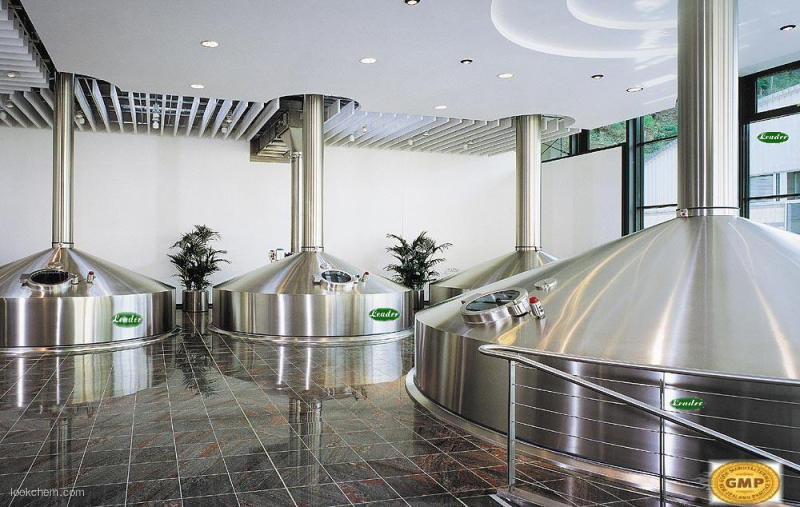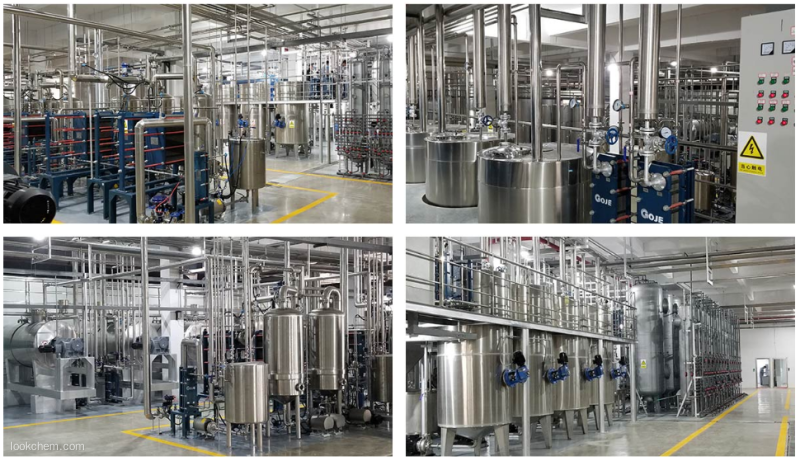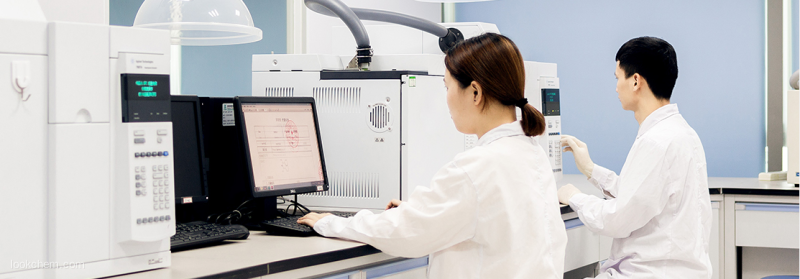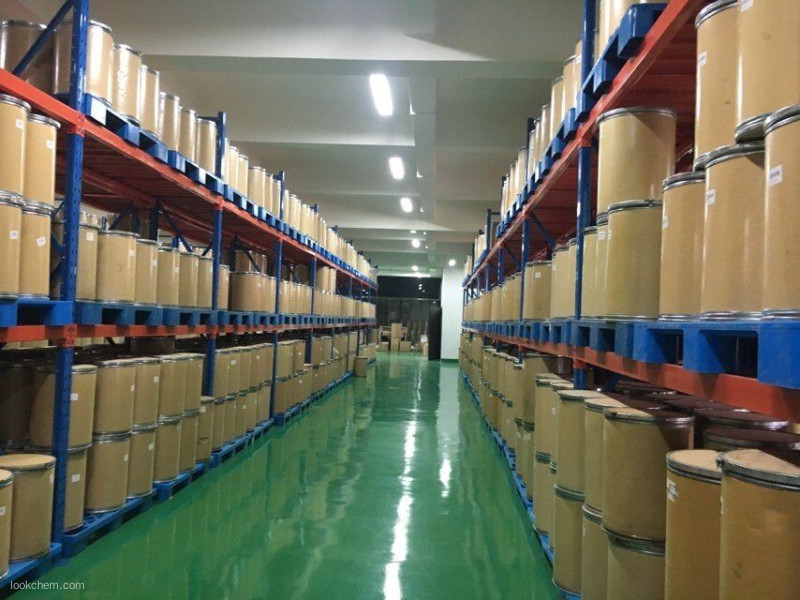PRODUCT DETAILS
| LOCUST BEAN GUM Basic information |
| Product Name: |
LOCUST BEAN GUM |
| Synonyms: |
Carobbeanextract;carobflour;Carobgum;carobseedgum;ceratoniagum;fructoline;indalcaabv;johannisbrotmehl |
| CAS: |
9000-40-2 |
| MF: |
C10H11ClN2O2 |
| MW: |
226.65954 |
| EINECS: |
232-541-5 |
| Product Categories: |
|
| Mol File: |
9000-40-2.mol |
 |
| |
| LOCUST BEAN GUM Chemical Properties |
| Melting point |
>200°C (dec.) |
| FEMA |
2648 | LOCUST GUM (CERATONIA SILIQUA L.) |
| storage temp. |
Sealed in dry,Room Temperature |
| solubility |
Ceratonia is dispersible in hot water, forming a sol having a pH 5.4–7.0 that may be converted to a gel by the addition of small amounts of sodium borate. In cold water, ceratonia hydrates very slowly and incompletely. Ceratonia is practically insoluble in ethanol. |
| form |
Solid |
| color |
Off-White to Light Beige |
| EPA Substance Registry System |
Carob gum (9000-40-2) |
| Provider |
Language |
| SigmaAldrich |
English |
| |
| LOCUST BEAN GUM Usage And Synthesis |
| Chemical Properties |
branched, nonionic polymer. |
| Chemical Properties |
Ceratonia occurs as a yellow-green or white colored powder. Although odorless and tasteless in the dry powder form, ceratonia acquires a leguminous taste when boiled in water. |
| Chemical Properties |
Carob bean gum is a natural product obtained from the endosperm of milled seeds from the fruit pod of C. siliqua. Carob bean gum is obtained from the macerated endosperm of the seeds of the fruit pod of the carob tree. This endosperm, comprising 42 to 46% of the kernel, contains virtually all of the galactomannan present in the seed. Galactomannan is not found in the kibble. Carob bean gum is used as a food stabilizer and thickener, a flavor and/or flavor modifier, an emulsifier, a texturizer and a solvent/ carrier/encapsulating agent. |
| Physical properties |
It is a white to yellowish-white powder. It is dispersible in either hot or cold water, forming a solution having a pH between 5.4 and 7.0, which may be converted to gel by the addition of small amounts of sodium borate. |
| Uses |
Locust bean gum (LBG, galactomannan polysaccharide) from Ceratonia siliqua seeds may be used as a substrate to help identify, differentiate and characterize mannanase(s), such as the β-Mannanases (EC 3.2.1.78). LBG may be used in the development of drug delivery devices. LBG may be used to study its properties as a protective agent on both eucalyptus and microcrystalline cellulose destruction of crystallinity by ball milling. LBG may be used to study its properties as a food additive that reduces spoilage caused by Aspergillus flavus. LBG may be used as a starting material for the organic synthesis of hyperbranched N-glycan core structures.
|
| Uses |
Locust Bean Gum is a gum that is a galactomannan obtained from the plant seed from the locust bean tree known as ceratonia siliqua. it has a mannose:galactose ratio of approximately 4:1. its properties include swelling partially in cold water but requiring heating to approximately 82°c for complete solubility. it provides high viscos- ity, forms gels with xanthan gum upon heating and cooling of the solution, and functions as a water binder. it can make agar or car- rageenan gels more elastic. its uses include processed cheese, ice cream, bakery products, soups, and pies. typical usage level is 0.1– 1.0%. it is also called carob gum or saint john’s bread, and is scien- tifically called carubin. |
| Production Methods |
Ceratonia is a naturally occurring material obtained from the ground endosperms separated from the seeds of the locust bean tree, Ceratonia siliqua (Leguminosae). The tree is indigenous to southern Europe and the Mediterranean region. |
| General Description |
Off-white to yellow-green powder. Odorless and tasteless, but acquires a leguminous taste when boiled in water. |
| Air & Water Reactions |
Insoluble in water. |
| Health Hazard |
ACUTE/CHRONIC HAZARDS: When heated to decomposition LOCUST BEAN GUM emits acrid smoke and fumes. |
| Fire Hazard |
Flash point data for LOCUST BEAN GUM are not available. However, LOCUST BEAN GUM is probably combustible. |
| Pharmaceutical Applications |
Ceratonia is a naturally occurring material generally used as a substitute for tragacanth or other similar gums. A ceratonia mucilage that is slightly more viscous than tragacanth mucilage may be prepared by boiling 1.0–1.5% of powdered ceratonia with water. As a viscosity-increasing agent, ceratonia is said to be five times as effective as starch and twice as effective as tragacanth. Ceratonia has also been used as a tablet binder and is used in oral controlled-release drug delivery systems approved in Europe and the USA.
Ceratonia is widely used as a binder, thickening agent, and stabilizing agent in the cosmetics and food industry. In foods, 0.15–0.75% is used. Therapeutically, ceratonia mucilage is used orally in adults and children to regulate intestinal function. |
| Safety Profile |
Mildly toxic by ingestion. When heated to decomposition it emits acrid smoke and irritating fumes. |
| Safety |
Ceratonia is generally regarded as an essentially noncarcinogenic, nontoxic and nonirritant material. Therapeutically, it has been used in oral formulations for the control of vomiting and diarrhea in adults and children; 20–40 g daily in adults has been used dispersed in liquid. As an excipient, ceratonia is used in oral controlledrelease formulations approved in Europe and the USA.
Ceratonia is also widely used in food products. The WHO has not specified an acceptable total daily intake for ceratonia as the total daily intake arising from its use at the levels necessary to achieve the desired effect, and from its acceptable background in food, was not considered to represent a hazard to health. Ceratonia hypersensitivity has been reported, in a single case report, in an infant. However, ceratonia is said to be nonallergenic in children with known allergy to peanuts.
LD50 (hamster, oral): 10.0 g/kg
LD50 (mouse, oral): 13.0 g/kg
LD50 (rabbit, oral): 9.1 g/kg
LD50 (rat, oral): 13.0 g/kg |
| storage |
The bulk material should be stored in a well-closed container in a cool, dry place. Ceratonia loses not more than 15% of its weight on drying. |
| Incompatibilities |
The viscosity of xanthan gum solutions is increased in the presence of ceratonia. This interaction is used synergistically in controlledrelease drug delivery systems. |
| Regulatory Status |
GRAS listed. Accepted for use in Europe as a food additive. In Europe and the USA, ceratonia has been used in oral tablet formulations. |
| |
| LOCUST BEAN GUM Preparation Products And Raw materials |
|
|
|
|
|
|
|
|
|
|
|
|
|
|
|
|
|
|
|
|
About US
Leader Biochemical Group is a large leader incorporated industry manufacturers and suppliers of advanced refined raw materials From the year of 1996 when our factory was put into production to year of 2020, our group has successively invested in more than 52 factories with shares and subordinates.We focus on manufacture Pharm & chemicals, functional active ingredients, nutritional Ingredients, health care products, cosmetics, pharmaceutical and refined feed, oil, natural plant ingredients industries to provide top quality of GMP standards products.All the invested factories' product lines cover API and intermediates, vitamins, amino acids, plant extracts, daily chemical products, cosmetics raw materials, nutrition and health care products, food additives, feed additives, essential oil products, fine chemical products and agricultural chemical raw materials And flavors and fragrances. Especially in the field of vitamins, amino acids, pharmaceutical raw materials and cosmetic raw materials, we have more than 20 years of production and sales experience. All products meet the requirements of high international export standards and have been recognized by customers all over the world. Our manufacture basement & R&D center located in National Aerospace Economic & Technical Development Zone Xi`an Shaanxi China. Now not only relying on self-cultivation and development as well as maintains good cooperative relations with many famous research institutes and universities in China. Now, we have closely cooperation with Shanghai Institute of Organic Chemistry of Chinese Academy of Science, Beijing Institute of Material Medical of Chinese Academy of Medical Science, China Pharmaceutical University, Zhejiang University. Closely cooperation with them not only integrating Science and technology resources, but also increasing the R&D speed and improving our R&D power. Offering Powerful Tech supporting Platform for group development. Keep serve the manufacture and the market as the R&D central task, focus on the technical research. Now there are 3 technology R & D platforms including biological extract, microorganism fermentation and chemical synthesis, and can independently research and develop kinds of difficult APIs and pharmaceutical intermediates. With the strong support of China State Institute of Pharmaceutical Industry (hereinafter short for CSIPI), earlier known as Shanghai Institute of Pharmaceutical Industry (SIPI), we have unique advantages in the R & D and industrialization of high-grade, precision and advanced products. Now our Group technical force is abundant, existing staff more that 1000 people, senior professional and technical staff accounted for more than 50% of the total number of employees, including 15 PhD research and development personnel, 5 master′ S degree in technical and management personnel 9 people. We have advanced equipment like fermentation equipment and technology also extraction, isolation, purification, synthesis with rich production experience and strict quality control system, According to the GMP required, quickly transforming the R&D results to industrial production in time, it is our advantages and our products are exported to North and South America, Europe, Middle East, Africa, and other five continents and scale the forefront in the nation, won good international reputation. We believe only good quality can bring good cooperation, quality is our key spirit during our production, we are warmly welcome clients and partner from all over the world contact us for everlasting cooperation, Leader will be your strong, sincere and reliable partner in China.
Group profiles
Our Factories production lines



Our Factories R&D ability


Our Factories warehouse




 Premiumsupplier
Premiumsupplier 



